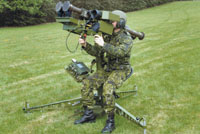Denmark Adopts Flexible Command And Control Platform
 |
| The HDMS Absalon was the first Danish navy vessel in a new class of ships to receive C-Flex, which uses the T-Core software as the basis for the combat management systems. Terma A/S developed the software. |
Upgrade facilitates operations with allies.
The Danish military is implementing a versatile software platform for its naval and land command and control systems that has proved to be an affordable means to support data fusion over legacy communications links. Featuring an open architecture, the platform provides generic command, control and communications functions and flexibility in subsystem integration. It is being installed on the country’s new ships as well as being retrofitted onto existing vessels.
Known as T-Core, the system was developed by Terma A/S, Lystrup, Denmark, and supports real-time operations for naval, ground and airborne applications used for command, control, communications, computers and intelligence (C4I). Development of the platform began in 1999 in response to a requirement identified from within the company rather than to address a specific customer requirement.
According to Eric Kressel, director of command, control, communications, computers, intelligence, surveillance and reconnaissance, and network-centric warfare at Terma Aerospace and Defense, from the start the company decided that the product should concentrate on the common components necessary for real-time operations. “Terma had supplied C4I systems to the Danish navy since the early 1980s. By 1999, we had supplied three generations of system technologies. In the traditional fashion, they were developed more or less from scratch, reusing only the knowledge and experience of a few employees. We realized that this would not be feasible in the future because very few customers, and certainly not our client base, were willing to pay the full development cost,” Kressel says.
Initial scoping of the task concluded that what would become T-Core should be based around four distinct features. The first was a C4I framework that would contain all the standard command, control and communications (C3) functions. “You could call it a common operational environment,” Kressel shares. Second, the company decided that the software platform would consist of interchangeable functional area subsystems that implement domain-specific applications such as naval gun fire control. Third, rather than a generic human-machine interface, T-Core would be designed to enable customers to build their own operator’s screen. “While it is true that each service metaphorically sees things differently, it is often literally the case on console screens,” he notes. Finally, T-Core was to be built to operate independently of specific hardware and operating system requirements.
The aim, Kressel explains, was to offer T-Core to users as an operating environment that would be independent of any hardware or operating systems and that also would have the capability to introduce a human-machine interface and function-specific applications according to the particular implementation of T-Core. For example, certain applications for naval combat management systems (CMS) would not be necessary on a vehicle-mounted battle management system, and vice versa. However, it is no small task to provide the common functionality required by both areas. Terma numbers these functions in the thousands and describes the functionality provided by T-Core as furnishing the background capabilities that users take for granted as well as those that are essential for mission success.
These functions range from front-line applications, such as situational awareness and display, track and alert management, to datalink management and message handling. Communications are integrated into the platform; any communications based on Internet protocol (IP) can operate with T-Core. As a result, the software can be operated with all recognized NATO and allied data communication channels. Other operations include weapons control and key systems management and training tools such as administration, systems monitoring, security management and simulation management.
T-Core entered service as part of the Royal Danish Navy’s new CMS in both new and existing naval vessels. It also is in place in a distributed ground-based air defense network optimized for expeditionary warfare. The next step for T-Core is to develop a battle management system linking individual vehicles over a real-time tactical Internet. “This is not the limit. T-Core has a number of other applications, where the issues are situational awareness, sensor integration and fusion, and wireless tactical communication,” Kressel states.
In 2001, the Danish navy signed a contract with Terma to update its C3 system using the T-Core approach. The system was delivered in December 2003. The company used T-Core as the basis for the new standard CMS for Royal Danish Navy vessels, where it is known as C-Flex.
C-Flex is being fitted both to new vessels and as a replacement for the existing Phillips Ericsson Terma/Command Control Communications (PET/C3) CMS system, which originated in the 1980s as a cooperation between Terma and other companies who later became known as Saab Tech. “The idea is that you add the pertinent domain applications that are required given the C4I systems architecture. The applications added in C-Flex are on top of T-Core and are viewed as what make it into a CMS for naval applications,” Kressel says.
Originally, C-Flex was procured for six of the Standard Flex 300 vessels. Because of a recent shift in defense policy, however, the focus has moved from the StanFlex class to international operations comprising the new Absalon-class flexible support ships.
 |
| The Danish army’s Low Level Air Defense System combined with a Stinger is the first ground installation of T-Core. Terma officials believe this approach can be extended, using a range of communication solutions, to lay the groundwork of an all-Internet-protocol-based tactical Internet and battle management systems. |
Implementing C-Flex has enabled off-the-shelf solutions to be used in the console, resulting in significant size, weight and power reductions at the console level. The legacy PET/C3 weighed more than 400 pounds and required considerable cooling. This has been replaced with a modern Windows-based console with flat panel displays. The computer power required to drive the screen has been moved below deck in special racks and has been connected with fiber optic cabling. This has reduced the amount of space needed because the depth of the console has been cut in half from nearly 35 inches to less than 18 inches. This change also has eliminated the need for cooling and has given users an intuitive and a well-known interface that resembles Windows, Kressel says.
Describing the solution as incorporating an “open architecture” is certainly not unique—many freely use the term. However, Kressel explains what Terma believes it means for T-Core. “We define the term ‘open architecture’ as the ability for the customer to integrate third-party products as and when they want. Interfacing can be done using a CORBA interface, the Java RMI [Remote Method Invocation] system, message interfaces and Windows for human-machine interface applications.
“We have used a de facto standard throughout the design. For example, all error and status messages use the SMTP [simple mail transfer protocol] standard, and the system is monitored using HP Openview.” He warns, however, that just because a system is deemed “open” does not mean that making changes is simple. Someone still has to take overall project management and systems integration responsibility to do that, Kressel states.
There have been recent attempts to define the term open architecture. One such initiative is the U.S. Navy’s Navy Open Architecture (NOA). During the early stages of the U.S. Littoral Combat Ship program, three of the competitors—Raytheon, Northrop Grumman and Lockheed Martin—assessed T-Core as part of the C-Flex CMS. The assessment found that C-Flex was approximately 80 percent NOA-compliant. The CMS, however, had not been developed with the NOA in mind, and this degree of compliance, explains Kressel, illustrates T-Core’s level of openness. Kressel adds that Terma has yet to decide whether C-Flex will work toward becoming 100 percent NOA-compliant.
Terma was originally awarded the Danish Army Low Level Air Defense System (DALLADS) Control and Warning System contract in 1997. This contract integrated air surveillance sensors with Stinger air defense missiles for an environment where real-time operation is absolutely necessary. Kressel explains that in 2002, Terma was awarded follow-on work in response to the army’s desire to change its command structure by focusing on platoon and company operations. The changes in air defense units are part of a wider transition by Denmark’s armed forces from a Cold War posture of territorial defense to one focused on expeditionary operations. This effort required a change in the networking structure, which was enabled through the implementation of T-Core.
Kressel asserts that DALLADS illustrates T-Core’s scalability. “The system contains a local area network—which is potentially wireless using a combat net radio—a number of PC-based workstations and servers. Hardware is supplied in accordance with redundancy and performance requirements. The T-Core package is scalable from a very small configuration with one or two workstations in an armored vehicle to more than 50 workstations as in the HDMS Absalon-class ships,” he notes.
He explains that through this solution Terma has developed the first version of what it calls a tactical Internet for platoon and company purposes, using a combat net radio to transmit IP-based communications. The type of implementation possible today is limited to DALLADS, but Kressel says that the goal is to extend it. “When you move beyond systems like DALLADS to something more widespread, the architecture and the requirements for how the various systems cooperate must evolve,” he states.
The company believes that T-Core can play a role in delivering a network of systems to the Danish army’s emerging requirements for network communications. It is working with fellow Danish company Maersk Data to provide a battle management system that combines T-Core with the latter’s Odin command information system.
“What Odin provides is the replication mechanism and situational awareness at the headquarters level. It provides the ability to transport and replicate command and plans from the upper level to lower levels and for the lower levels to report on enemy activity and their own position and send that upward through the network. Odin provides the facility to have the exact same situational awareness picture at any level of command. However, this is not real time. What T-Core provides is the tactical real-time element of the system, the situational awareness picture, which shows the immediate enemy and friends nearby, and the tactical communications between vehicles in a platoon or company,” Kressel explains. The incorporation of T-Core, which is communications-independent, would aid interoperability among NATO and allied partners, he adds. “T-Core doesn’t care what communications are used, as long as they are IP-based.”
While military customers are vital to the company, Terma is actively pursuing other customers. Kressel believes that the functionality that T-Core provides has applications beyond the strictly military market, citing the homeland security market as one avenue.
The company already has played a role in U.S. homeland security, he shares. It won contracts from prime contractor Lockheed Martin for 35 SCANTER 2001 radars for the U.S. Coast Guard’s Ports and Waterways Safety Systems program. “The idea is that we would also like to provide civil authorities with a well-defined situational awareness picture that is up to date and in real time,” he says.
Terma officials believe system houses will become the key customers for T-Core and is offering the system software as the basis for all company-led solutions in the CMS area. The firm also offers T-Core as an original equipment manufacturer solution that can be licensed by other companies and end users to build a combat management system independently of Terma.
The company is now promoting the benefits of reusable open architecture software on a global basis, although this is not a simple task. “It takes some time for the idea to sink in, not only in the system houses but also among customers as to the benefits they can get from using this kind of approach. The procurement people have not moved with the idea of reusing software and of buying off the shelf,” Kressel notes.
Adam Baddeley is a freelance technical writer based in the United Kingdom. He specializes in the area of command, control, communications, intelligence, surveillance, target acquisition and reconnaissance.




Comments